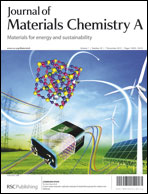New solution-processable small molecules as hole-transporting layer in efficient polymer solar cells†
Abstract
Small molecules TPDA, TPDB, and TPDH, comprising the same backbone TPD (N,N′-diphenyl-N,N′-bis(3-methylphenyl)-(1,1′-biphenyl)-4,4′-diamine) and different carboxyl side chains were designed and synthesized as hole-transporting materials in polymer solar cells. These small molecules demonstrated improved solubility in polar solvents due to the introduction of the weakly acidic carboxyl groups. The lengths of the side chains can also influence the film forming ability. Compared to conventional PEDOT:PSS, these small molecules showed higher transmittance in the visible range as revealed by UV-vis measurements. Desirable energy-level alignment for efficient hole-transporting and electron-blocking ability was indicated by their absorption and UPS spectra. Without applying any post-treatment to these buffer layers, comparable and improved device performances were achieved compared with PEDOT:PSS buffered control devices. A high power conversion efficiency of 6.51% was realized by a TPDB buffered device employing a low band gap polymer PBDTTPD as the active material, which showed ∼15% efficiency enhancement over the control devices. Equally important, better device stability was demonstrated by using TPDB as the new hole-transporting layer.


 Please wait while we load your content...
Please wait while we load your content...